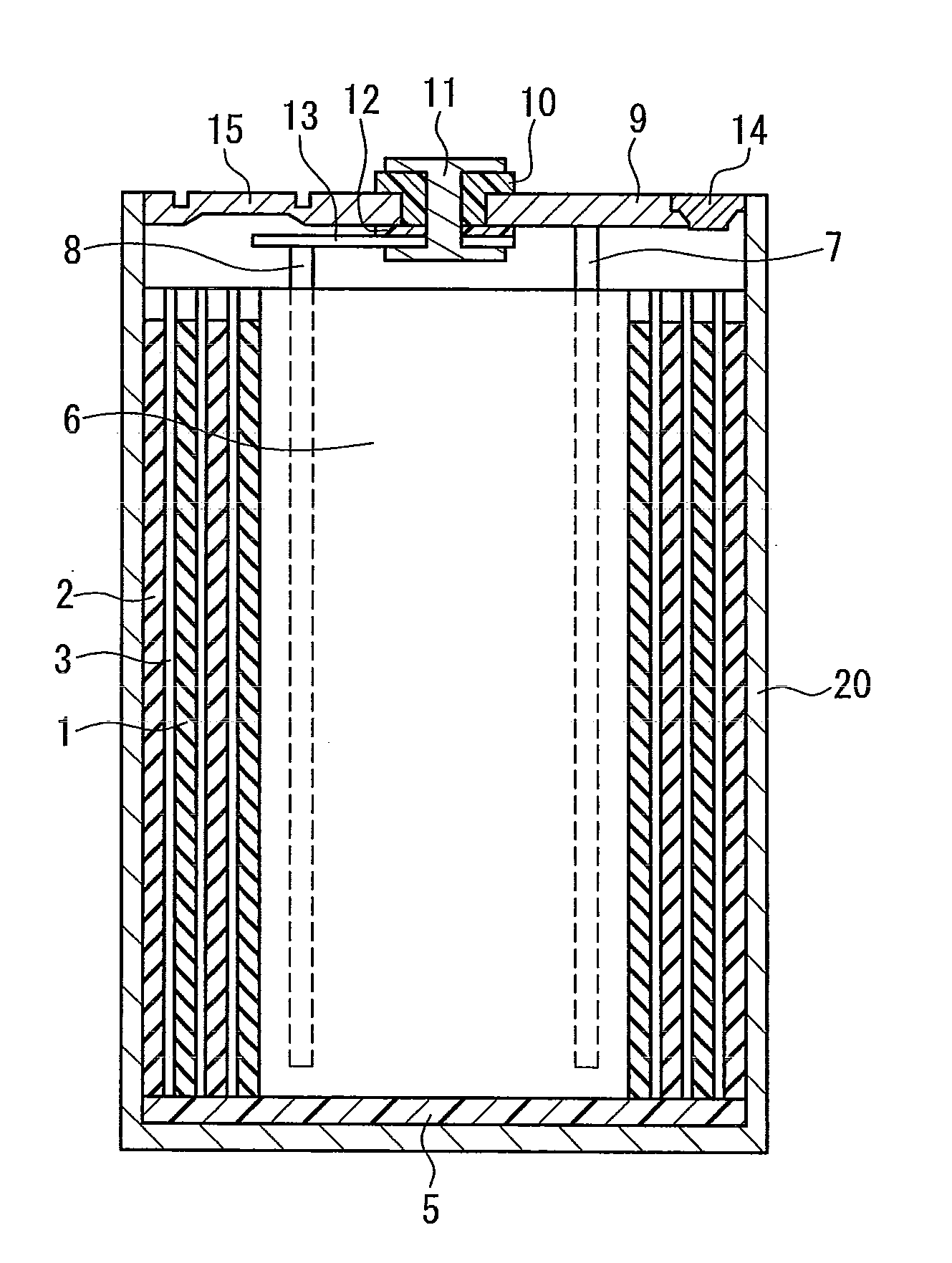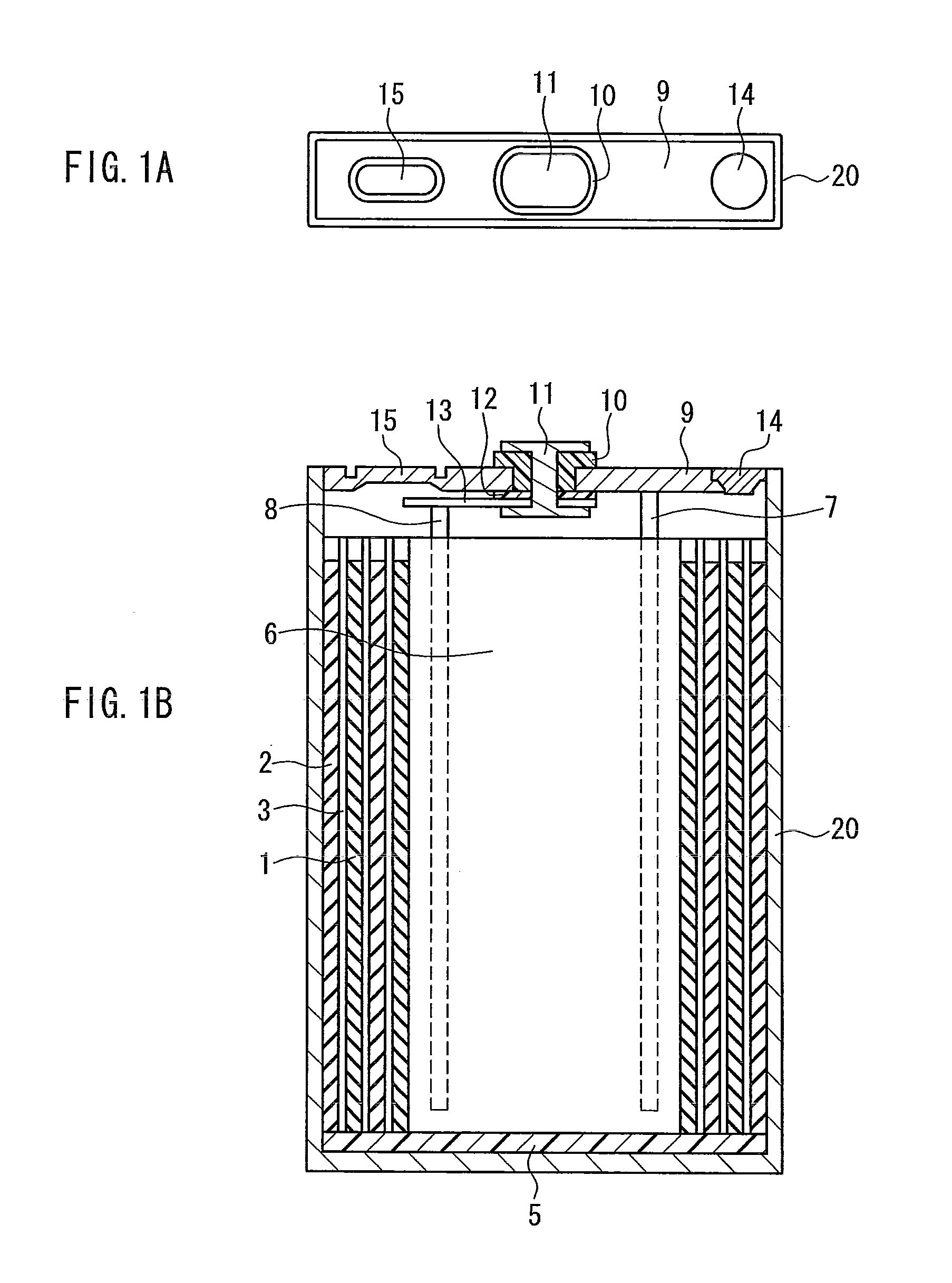Battery separator and nonaqueous electrolyte battery
a battery separator and electrolyte technology, applied in the field of nonaqueous electrolyte batteries, can solve the problems of reducing the thickness of the separator, short circuit, and easy shrinkage of the common separator, and achieve excellent safety and suppress heat generation.
- Summary
- Abstract
- Description
- Claims
- Application Information
AI Technical Summary
Benefits of technology
Problems solved by technology
Method used
Image
Examples
example 1
Production of Positive Electrode
[0088]A positive electrode mixture containing paste was prepared by mixing 90 parts by mass of LiCo0.33Ni0.33Mn0.33O2 (positive active material), 7 parts by mass of acetylene black (conductive assistant), and 3 parts by mass of PVDF (binder) uniformly by using NMP as a solvent. This paste was intermittently applied to both surfaces of a current collector (aluminum foil) with a thickness of 15 μm so that the applied length was 280 mm on the upper surface and 210 mm on the lower surface, which then was dried and calendered. Thus, the thicknesses of the positive electrode mixture layers were adjusted so that the total thickness was 150 μm. Subsequently, this current collector having the positive electrode mixture layers was cut into a length of 300 mm and a width of 43 mm, thereby producing a positive electrode. Moreover, a lead portion was formed by welding a tab to the exposed portion of the aluminum foil of the positive electrode.
[0089]
[0090]A negativ...
example 2
[0095]A positive electrode was produced in the same manner as Example 1 except that the positive active material was changed to LiMn1.9Al0.1O4.
[0096]The same slurry as that in Example 1 was applied to the surface of a PET nonwoven fabric (with a thickness of 15 μm and a weight of 10 g / m2) using a dip coater and dried, thereby providing a heat-resistant layer with a thickness of 18 μm. Then, a water dispersion of polyethylene fine particles (with an average particle size of 1 μm, a melting point of 125° C., and a solid content of 20 mass %) was applied to the surface of the heat-resistant layer using a die coater and dried, thereby providing a shutdown layer. Thus, a separator was produced. The thickness of the separator was 23 μm.
[0097]A nonaqueous electrolyte battery was produced in the same manner as Example 1 except that the positive electrode and the separator of this example were used.
example 3
[0098]A positive electrode was produced in the same manner as Example 1 except that the positive active material was changed to LiFePO4.
[0099]Next, 600 g of an NMP solution of PVDF serving as a binder (with a solid content of 15 mass %) and 1000 g of NMP were put in a container and stirred at room temperature until the solution was uniform. Then, 3000 g of an alumina powder serving as heat-resistant fine particles (an average particle size: 0.4 μm, a proportion of particles with a particle size of 0.2 μm or less: 0 vol %, and a proportion of particles with a particle size of 2 μm or more: 0 vol %) was added to this solution at four different times, and dispersed with a Disper at 2800 rpm for 1 hour, resulting in a uniform slurry. Next, the slurry was applied to the surface of the above positive electrode using a die coater and dried, thereby providing a heat-resistant layer with a thickness of 4 μm.
[0100]A nonaqueous electrolyte battery was produced in the same manner as Example 1 e...
PUM
| Property | Measurement | Unit |
|---|---|---|
| particle size | aaaaa | aaaaa |
| particle size | aaaaa | aaaaa |
| thermal shrinkage ratio | aaaaa | aaaaa |
Abstract
Description
Claims
Application Information
 Login to View More
Login to View More - R&D
- Intellectual Property
- Life Sciences
- Materials
- Tech Scout
- Unparalleled Data Quality
- Higher Quality Content
- 60% Fewer Hallucinations
Browse by: Latest US Patents, China's latest patents, Technical Efficacy Thesaurus, Application Domain, Technology Topic, Popular Technical Reports.
© 2025 PatSnap. All rights reserved.Legal|Privacy policy|Modern Slavery Act Transparency Statement|Sitemap|About US| Contact US: help@patsnap.com



